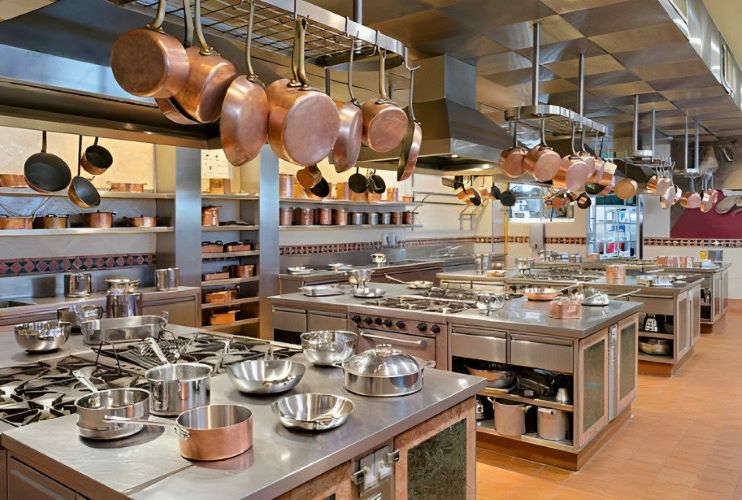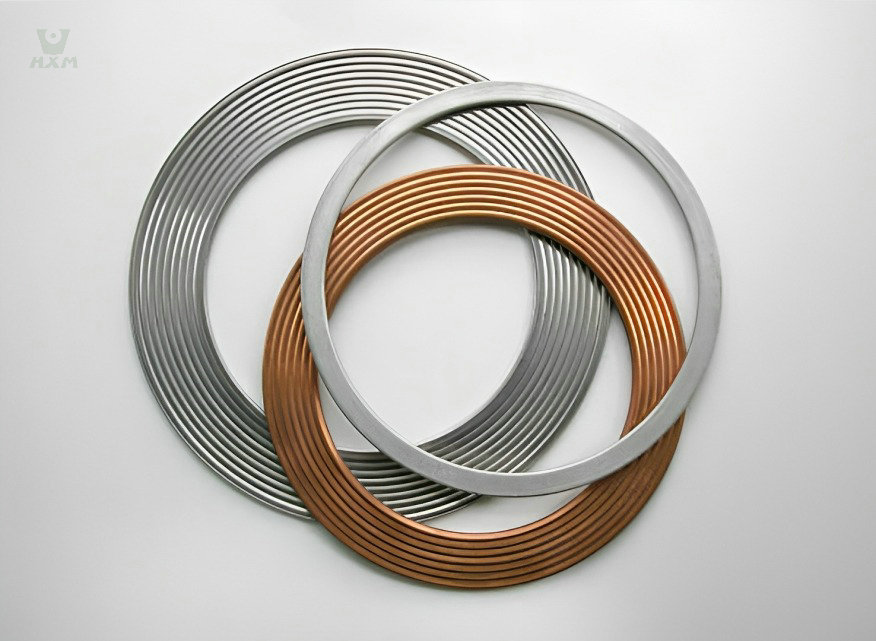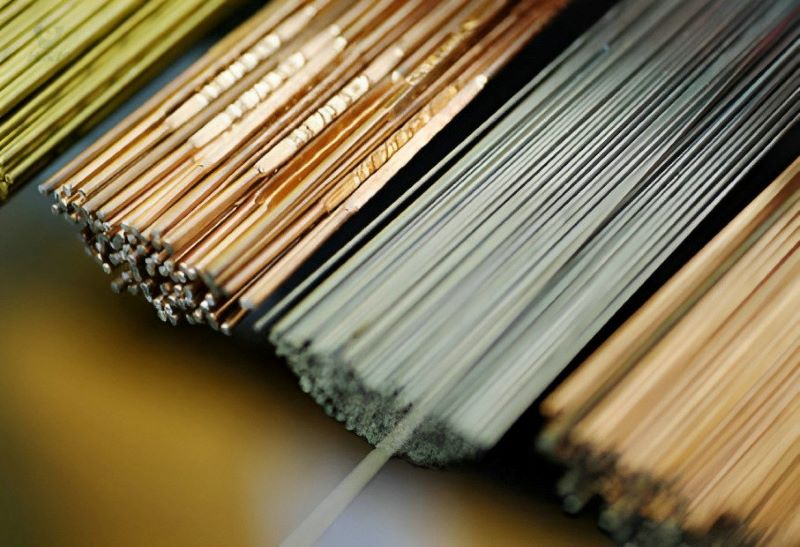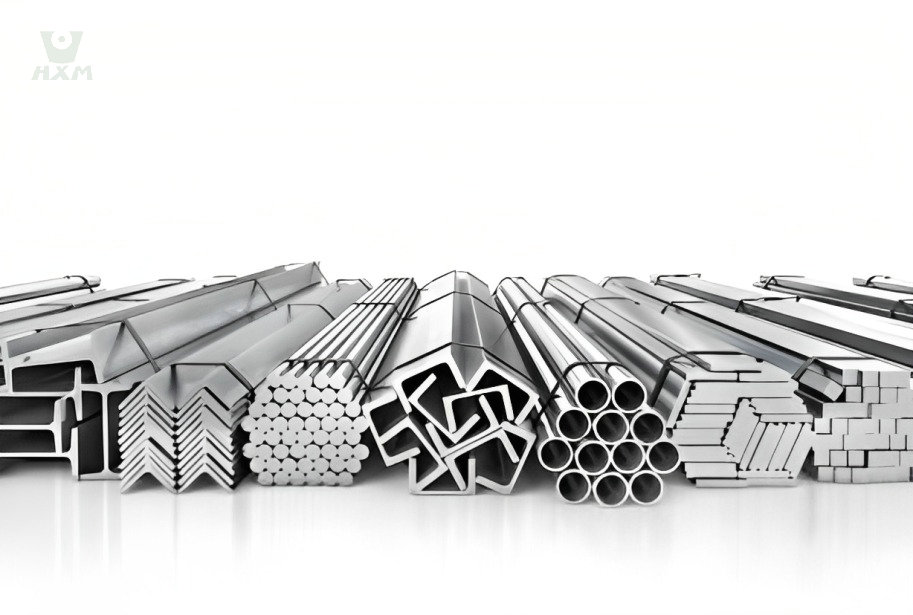Stainless Steel manufacturer - Huaxiao Stainless Steel
stainless steel VS copper, Which is Better?
stainless steel vs copper, which are two titans have long reigned supreme in the world of metallurgy. Stainless steel, the modern marvel of corrosion resistance, locks horns with copper, the age-old champion of electrical conductivity. As we delve into this head-to-head clash of the metallic titans, we explore the myriad facets that make stainless steel VS copper indispensable in their own right.

stainless steel VS copper

stainless steel VS copper
stainless steel VS copper, What's Differences?
Stainless steel VS copper, which is better? It is a multifaceted one, dependent on specific needs and contexts. Stainless steel, a remarkable alloy known for its resistance to corrosion, is a stalwart in industries where durability and hygiene are paramount. Its chromium content forms a protective oxide layer, making it ideal for everything from kitchen appliances to medical equipment.
On the other hand, copper stands as an excellent conductor of electricity and heat. Its conductivity properties have made it irreplaceable in electrical wiring, electronics, and heating applications. Yet, copper’s susceptibility to corrosion and its relatively lower strength limit its usage in certain environments.
stainless steel VS copper - Property
| Property | Stainless Steel | Copper |
|---|---|---|
| Composition | An alloy primarily composed of iron, chromium, nickel, and other elements. Chromium content typically at least 10.5%. | A pure elemental metal with atomic number 29. Minimal impurities. |
| Corrosion Resistance | Exceptional corrosion resistance due to the formation of a protective oxide layer (passive layer) when exposed to oxygen. | Susceptible to corrosion, and it develops a greenish patina over time when exposed to oxygen and moisture. |
| Electrical Conductivity | Moderate electrical conductivity. | Excellent electrical conductivity, making it a preferred choice for electrical wiring and transmission. |
| Thermal Conductivity | Moderate thermal conductivity. | High thermal conductivity, making it suitable for heat exchange applications. |
| Malleability and Ductility | Exhibits malleability and ductility. | Highly malleable and ductile, easy to form into various shapes and configurations. |
| Strength and Durability | High tensile strength and exceptional durability. | May not possess the same strength and durability as stainless steel. |
| Common Applications | Versatile, used in various industries, including construction, automotive, healthcare, aerospace, and more. | Predominantly used in electrical applications, plumbing, and artistic endeavors. |
Stainless Steel manufacturer - Huaxiao Stainless Steel
stainless steel VS copper
Composition and inherent Properties
composition and inherent properties of stainless steel
Stainless steel, a triumph of metallurgical engineering, derives its exceptional properties from a well-balanced composition. This alloy primarily consists of iron, with significant additions of chromium, nickel, and other elements. The precise combination of these constituents is crucial to its performance in various applications.
Chromium, a cornerstone element, constitutes at least 10.5% of stainless steel’s composition. It endows the alloy with remarkable corrosion resistance. When exposed to oxygen, chromium forms a self-healing oxide layer on the surface, preventing further rusting or corrosion.
Nickel, another key component, enhances stainless steel’s ductility and impact resistance. This element aids in maintaining the austenitic structure of the alloy, even at lower temperatures.
Other alloying elements, such as molybdenum, contribute to specific properties. Molybdenum, for instance, enhances the alloy’s resistance to pitting corrosion in aggressive environments.
The resulting alloy exhibits outstanding mechanical properties, such as high tensile strength, toughness, and exceptional durability. Stainless steel’s versatility is evident in its application across diverse industries, from construction and automotive to healthcare and aerospace.
Stainless steel manufacturers play a pivotal role in tailoring compositions to suit varied requirements. By fine-tuning the proportions of alloying elements, they create specific grades of stainless steel optimized for particular applications, solidifying its position as an indispensable material in modern engineering.
composition and inherent properties of copper
Copper, an elemental metal found in the Earth’s crust, possesses a simple yet powerful composition. Its atomic number, 29, places it among the transition metals, and its unique properties stem from this elemental simplicity.
Copper, in its purest form, consists of almost entirely copper atoms, with minimal impurities. Its atomic structure features a single valence electron in its outermost energy level, giving it excellent electrical conductivity and malleability. This intrinsic property makes copper an ideal choice for electrical wiring and transmission.
One of copper’s hallmark characteristics is its striking reddish-brown color, which can develop a distinctive greenish patina over time when exposed to oxygen and moisture. This patina is a protective layer that shields the underlying metal from further corrosion.
Copper’s high thermal conductivity, coupled with its excellent electrical conductivity, renders it indispensable in heat exchange applications and electronics.
Furthermore, copper exhibits remarkable ductility and malleability, making it easy to form into various shapes and configurations. These qualities are pivotal in the production of intricate components and artistic works.
In addition to its electric and thermal conductivity, copper displays commendable resistance to corrosion. It is non-magnetic, which expands its range of applications in industries requiring non-magnetic materials.
Copper’s versatility is undeniable, as it finds applications in architecture, plumbing, electronics, and even artistic endeavors. Its intrinsic properties, combined with the ability to alloy with other metals for enhanced characteristics, underline copper’s enduring importance in the world of materials science.

Stainless Steel manufacturer - Huaxiao Stainless Steel
stainless steel VS copper
Corrosion Resistance and Durability
corrosion resistance of stainless steel
Stainless steel’s remarkable corrosion resistance and enduring durability are rooted in its unique composition and microstructure. This alloy’s inherent properties make it a stalwart in various environments, from harsh industrial settings to everyday household applications.
Stainless steel’s primary defender against corrosion is chromium, which forms a passive, self-repairing oxide layer when exposed to oxygen. This layer acts as an impervious shield, preventing further corrosion and rusting. The chromium content, typically at least 10.5%, is finely tuned by stainless steel manufacturers to meet specific environmental demands.
In aggressive and corrosive environments, such as chemical processing plants or offshore structures, stainless steel’s resistance to pitting and crevice corrosion is invaluable. This ability to withstand localized corrosion makes it a preferred choice where other metals might succumb.
Its durability is evident in its capacity to endure extreme temperatures and harsh conditions. From cryogenic applications to high-temperature furnaces, stainless steel retains its mechanical strength and structural integrity. This versatility extends its use across diverse industries, from petrochemical and pharmaceutical to food processing and construction.
The remarkable corrosion resistance and durability of stainless steel are attributed not only to its composition but also to the fine-tuning by stainless steel manufacturers who tailor alloys to meet specific needs. This ongoing quest for perfection in material science continues to reinforce the indispensable role of stainless steel in our modern world.
Corrosion Susceptibility and Durability of Copper
Copper, with its distinct properties and bright reddish-brown appearance, is widely utilized in various applications. However, its susceptibility to corrosion and long-term durability depends on several factors.
Corrosion Susceptibility
Exposure to Oxygen: Copper readily reacts with oxygen in the atmosphere, leading to the formation of a copper oxide layer on its surface. This layer often appears as a greenish patina and acts as a protective shield against further corrosion. While this patina is a corrosion-resistant barrier, it can be compromised in certain aggressive environments or when exposed to pollutants.
Acidic Environments: Copper is susceptible to corrosion in acidic environments. Acidic substances can dissolve the protective oxide layer, leaving the underlying copper vulnerable to further corrosion. Therefore, it may not be the best choice for applications involving strong acids or acidic atmospheres.
Long-Term Durability
Exterior Applications: Copper is known for its impressive long-term durability, especially in exterior applications. The gradual development of the greenish patina mentioned earlier serves as a self-repairing barrier against corrosion. This patina evolves over time and provides long-lasting protection.
Indoor Applications: In indoor settings with controlled conditions, copper can maintain its aesthetic appeal and durability over extended periods. It is often used in plumbing, electrical systems, and architectural designs due to its ability to withstand the test of time.
In summary, copper’s corrosion susceptibility and long-term durability are influenced by environmental factors. While it may be prone to corrosion in certain conditions, its ability to form a protective patina ensures its long-term durability, making it a preferred choice for various applications, especially when its unique properties, such as electrical conductivity and malleability, are required.

Stainless Steel manufacturer - Huaxiao Stainless Steel
stainless steel VS copper
Electrical Conductivity
superior electrical conductivity of copper
Copper is renowned for its exceptional electrical conductivity, making it an indispensable material in a wide array of electrical and electronic applications. Its superior conductivity can be attributed to its atomic structure and elemental purity.
Atomic Structure: Copper’s atomic structure plays a pivotal role in its outstanding electrical conductivity. It has a single valence electron in its outermost electron shell, which is relatively free to move through the lattice of copper atoms. This free movement of electrons, known as electron mobility, results in a high electrical conductivity.
Copper’s superior electrical conductivity, along with its malleability and durability, has positioned it as a foundational material in the electrical and electronic fields. Its role in enabling efficient energy transfer and information transmission is fundamental to modern technological advancements and our daily lives.
limited electrical conductivity of stainless steel
Stainless steel, although valued for its corrosion resistance and durability, has limited electrical conductivity due to its specific composition and atomic structure. This limitation influences its applications in various industries.
Factors Influencing Electrical Conductivity in Stainless Steel:
Composition: Stainless steel is primarily composed of iron, with the addition of chromium, nickel, and other alloying elements. These alloying elements can disrupt the free movement of electrons, leading to increased electrical resistance.
Atomic Structure: The atomic arrangement in stainless steel, particularly in austenitic grades, hinders electron mobility. This impediment restricts the flow of electric current, resulting in reduced electrical conductivity.
In conclusion, stainless steel’s limited electrical conductivity is a result of its composition and atomic structure. While it may not be a top choice for applications requiring high electrical conductivity, it excels in industries where corrosion resistance, durability, and biocompatibility take precedence over electrical properties. Its versatility makes it a valuable material in a wide range of industrial and commercial applications.

stainless steel VS copper
Physical and Mechanical Properties
Comparing Physical and Mechanical Properties
Stainless steel and copper are two distinct materials with varying physical and mechanical properties, making them suitable for different applications.
stainless steel VS copper
Physical Properties
- Stainless Steel: Stainless steel is denser than copper. The density of stainless steel depends on its specific alloy composition and ranges from 7.7 to 8.0 g/cm³.
- Copper: Copper has a lower density, typically around 8.92 g/cm³. This lower density makes copper lighter than stainless steel.
- Stainless Steel: Stainless steel has relatively poor electrical conductivity due to its alloy composition and atomic structure. It is not suitable for applications where high electrical conductivity is required.
- Copper: Copper is renowned for its excellent electrical conductivity. It ranks among the best conductors of electricity and is widely used in electrical and electronic applications.
- Stainless Steel: Stainless steel has lower thermal conductivity compared to copper. It is not as efficient in conducting heat.
- Copper: Copper is an excellent thermal conductor and is commonly used in heat exchangers and cooling applications.
stainless steel VS copper
Mechanical Properties
- Stainless Steel: Stainless steel is known for its high tensile strength, which varies depending on the alloy. Some stainless steel grades exhibit tensile strength comparable to that of structural steel.
- Copper: Copper has lower tensile strength compared to stainless steel. It is less suitable for load-bearing applications.
- Stainless Steel: Stainless steel exhibits varying levels of ductility depending on the alloy. It can be engineered to be ductile, making it suitable for forming and shaping.
- Copper: Copper is highly ductile and malleable, allowing it to be easily formed into various shapes and configurations.
- Stainless Steel: Stainless steel can be hardened through heat treatment, increasing its hardness. Hardened stainless steel is more resistant to wear and abrasion.
- Copper: Copper is relatively soft and has low hardness. It is susceptible to wear and is often alloyed with other materials to improve its hardness.
Some stainless steel grades are magnetic, whereas copper is not magnetic. This property can vary based on the specific alloy composition of stainless steel.
The selection of stainless steel or copper for a specific application may depend on the material’s properties, the stainless steel manufacturers’ specifications, and the requirements of the intended use. Stainless steel manufacturers play a crucial role in tailoring the material to meet specific needs, offering a wide range of options for various industries and applications.
how these properties affect their performance in different applications
Electrical and Electronic Applications:
Copper: Copper’s exceptional electrical conductivity makes it indispensable in electrical wiring, printed circuit boards, and electrical equipment. Its malleability allows it to be easily shaped into intricate conductive components, and its high thermal conductivity is beneficial in electronic cooling systems.
Stainless Steel: Some stainless steel grades are used in electronic applications where corrosion resistance and mechanical strength are required. Manufacturers can tailor stainless steel alloys for specific electronic components that need durability and resistance to environmental factors.Construction and Architecture:
Copper: Copper’s aesthetic appeal and corrosion resistance make it an excellent choice for roofing, gutter systems, and architectural accents. Its malleability allows for intricate designs.
Stainless Steel: Stainless steel, particularly in architectural applications, is favored for its strength, durability, and corrosion resistance. Stainless steel manufacturers offer a variety of finishes and designs for structural and decorative elements.Plumbing and Water Systems:
Copper: Due to its corrosion resistance, copper is commonly used for water supply lines, plumbing fixtures, and pipes. Its antimicrobial properties add to its appeal in potable water systems.
Stainless Steel: Stainless steel manufacturers provide options for plumbing applications that require resistance to aggressive fluids or environments, such as chemical processing plants.Transportation:
Copper: Copper is used in heat exchangers and radiators in automotive applications due to its excellent thermal conductivity.
Stainless Steel: Stainless steel, with its corrosion resistance, is often found in exhaust systems, chassis components, and structural elements in the automotive and aerospace industries.Food Processing and Medical Equipment:
Copper: Copper’s antimicrobial properties make it suitable for food and beverage processing equipment. It is also used in medical instruments.
Stainless Steel: Stainless steel is prevalent in food processing equipment, thanks to its corrosion resistance and ease of cleaning. Medical instruments, requiring biocompatibility and sterilization resistance, also benefit from stainless steel.Energy and Chemical Industries:
Copper: Copper’s excellent thermal and electrical conductivity find applications in heat exchangers and electrical conductors.
Stainless Steel: In the energy and chemical sectors, stainless steel is preferred for its corrosion resistance in pipes, tanks, and pressure vessels. Stainless steel manufacturers offer a range of grades tailored for specific chemical environments.
The choice between stainless steel and copper depends on the specific properties required for the application and the stainless steel manufacturers’ ability to customize materials to meet those requirements. Stainless steel’s adaptability, provided by stainless steel manufacturers, allows it to compete with copper in various fields, often excelling in durability and resistance to corrosion.
stainless steel VS copper
Environmental Impact and Sustainability
environmental impact of using stainless steel
Durability and Longevity: Stainless steel is renowned for its exceptional durability and longevity. It can withstand harsh environmental conditions and resist corrosion, ensuring a long service life for various applications, from infrastructure to consumer goods. This durability reduces the need for frequent replacements, saving resources and energy.
Recyclability: Stainless steel is highly recyclable, making it a sustainable choice. Stainless steel manufacturers often use recycled stainless steel scrap in their production processes, reducing the demand for virgin materials. Recycled stainless steel retains its quality and performance, further minimizing the environmental impact.
Energy Efficiency: Stainless steel manufacturing has become increasingly energy-efficient. Advanced processes and technology improvements have reduced energy consumption in the production of stainless steel. This not only lowers production costs but also minimizes the carbon footprint of stainless steel production.
Reduced Maintenance and Cleaning: Stainless steel’s resistance to staining and corrosion means it requires minimal maintenance and cleaning. This feature extends to applications like architectural structures, where less frequent cleaning reduces the use of cleaning agents and water, promoting sustainability.
Low Emission Levels: Stainless steel manufacturing processes, such as electric arc furnaces, have relatively low emissions compared to some other metals. The industry has made efforts to reduce its environmental impact, including emissions of greenhouse gases and air pollutants.
Reduced Material Waste: Precision manufacturing techniques minimize material waste during the production of stainless steel components, which is environmentally responsible. Manufacturers aim for high material utilization rates, reducing scrap and waste generation.
Stainless Steel’s Impact in Transportation: In the transportation sector, stainless steel’s lightweight yet durable properties contribute to fuel efficiency and reduced emissions in vehicles, particularly in the aerospace and automotive industries.
Life Cycle Assessment (LCA): Comprehensive life cycle assessments of stainless steel products are conducted to measure their environmental impact throughout their entire life cycle, from raw material extraction to manufacturing, use, and end-of-life recycling. This helps in identifying areas for improvement and sustainability.
Stainless steel’s sustainability goes beyond its immediate use in applications. Its impressive recyclability, low maintenance requirements, and energy-efficient manufacturing processes underscore its positive environmental impact. Furthermore, continuous efforts by stainless steel manufacturers to improve sustainability practices have made it a responsible and eco-friendly choice for a wide range of applications.
environmental implications and recyclability of copper
Natural Abundance: Copper is one of the most abundant metals in the Earth’s crust, and its mining operations are widely distributed worldwide. While its availability is not a significant concern, the environmental impact of copper mining can vary, depending on mining practices and locations.
Resource Intensity: Copper production, particularly from primary sources, can be resource-intensive. It involves substantial energy consumption and the extraction of large amounts of ore. The environmental implications include habitat disruption, water use, and emissions of pollutants.
Recycling: Copper is highly recyclable, and its recycling rate is relatively high. Recycling copper reduces the need for new mining and energy-intensive refining processes, thus lowering the environmental impact. Copper and its alloys can be recycled infinitely without a significant loss of quality.
Energy Efficiency: Primary copper production requires substantial energy inputs, and efforts to improve energy efficiency in copper refining have been ongoing. Advances in smelting and refining processes have reduced the energy intensity of primary copper production.
Emissions: The copper industry has made efforts to reduce emissions of pollutants and greenhouse gases. Modern copper smelters employ technologies to capture and minimize emissions of sulfur dioxide and other pollutants.
Water Usage: Water is a critical resource in copper mining and refining. Sustainable practices include water recycling and reducing water consumption in copper production.
Impact on Aquatic Ecosystems: Copper mining and manufacturing processes can result in the release of copper into aquatic ecosystems, which, in elevated concentrations, can be harmful to aquatic life. Regulatory measures are in place to minimize such impacts.
Lifecycle Assessment (LCA): Comprehensive life cycle assessments of copper products consider their environmental impact throughout their entire lifecycle. This includes mining, refining, manufacturing, use, and recycling. LCA helps identify areas for improvement and sustainable practices.
Recyclability: Copper is prized for its high recyclability. Recycling copper reduces the environmental burden associated with primary copper production and decreases the demand for virgin resources.
In summary, the environmental implications of copper are closely tied to the efficiency of mining and refining processes and the industry’s efforts to minimize resource consumption, emissions, and other environmental impacts. The recyclability of copper is a significant advantage in reducing its environmental footprint. Continuous improvements in technology and sustainable practices contribute to a more responsible and eco-friendly use of copper in various applications.
stainless steel VS copper
conclusion
In conclusion, both stainless steel and copper offer distinct advantages and disadvantages, and their suitability in specific applications depends on various factors.
Stainless Steel:
- Stainless steel excels in environments requiring corrosion resistance and durability. It is favored in industries like construction, aerospace, and medical equipment. Its unique properties, such as high strength, low maintenance, and long-lasting performance, make it a preferred choice.
Copper:
- Copper stands out for its exceptional electrical conductivity, making it essential in electrical and electronic applications. It also possesses natural antimicrobial properties, which have led to its use in healthcare settings. Additionally, copper is a highly recyclable material, contributing to its sustainability.
Considerations for Choosing:
The choice between stainless steel and copper should be based on the specific requirements of the application. Factors such as corrosion resistance, electrical conductivity, recyclability, and environmental impact need to be considered.
In cases where corrosion resistance and durability are paramount, stainless steel may be the better choice. On the other hand, for electrical or antimicrobial applications, copper’s superior conductivity and natural properties make it the ideal option.
Sustainability concerns can also influence the decision, with copper’s high recyclability offering an eco-friendly advantage.
It’s crucial to consult with experts, engineers, and manufacturers, such as stainless steel manufacturers for stainless steel applications or copper suppliers for copper applications, to ensure the most suitable material is selected for the intended use.
Ultimately, the decision between stainless steel and copper depends on a careful evaluation of the specific requirements and considerations of the application at hand. Each material has its strengths and can offer unique benefits when applied correctly.
stainless steel VS copper
Do You Want To Boost Your Business?
drop us a line and keep in touch




